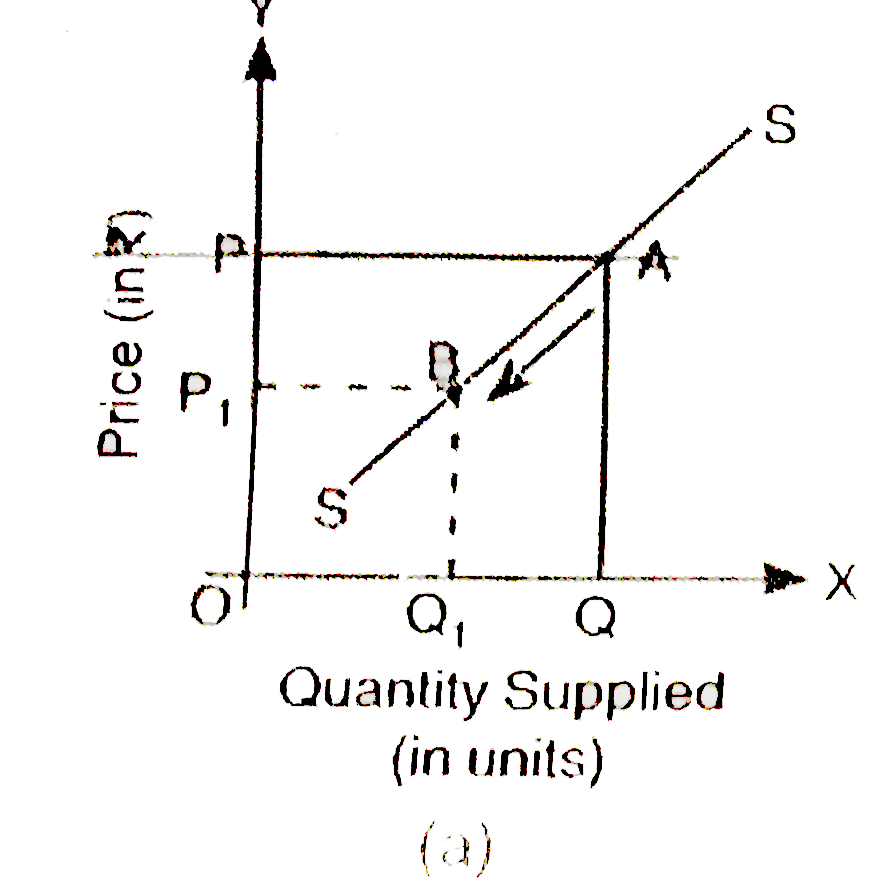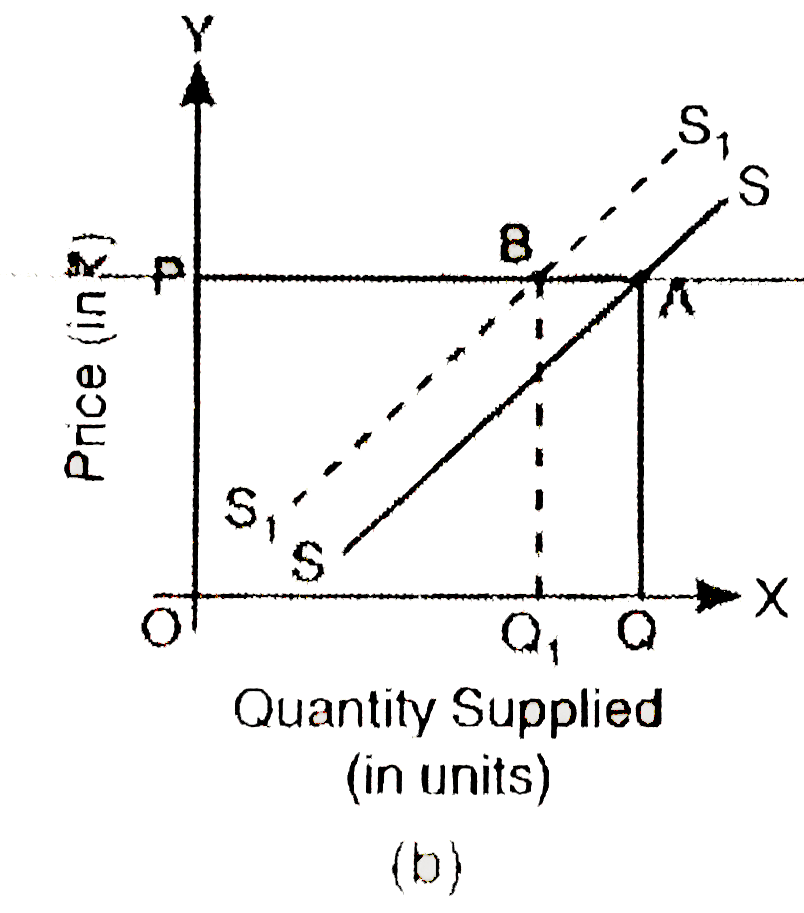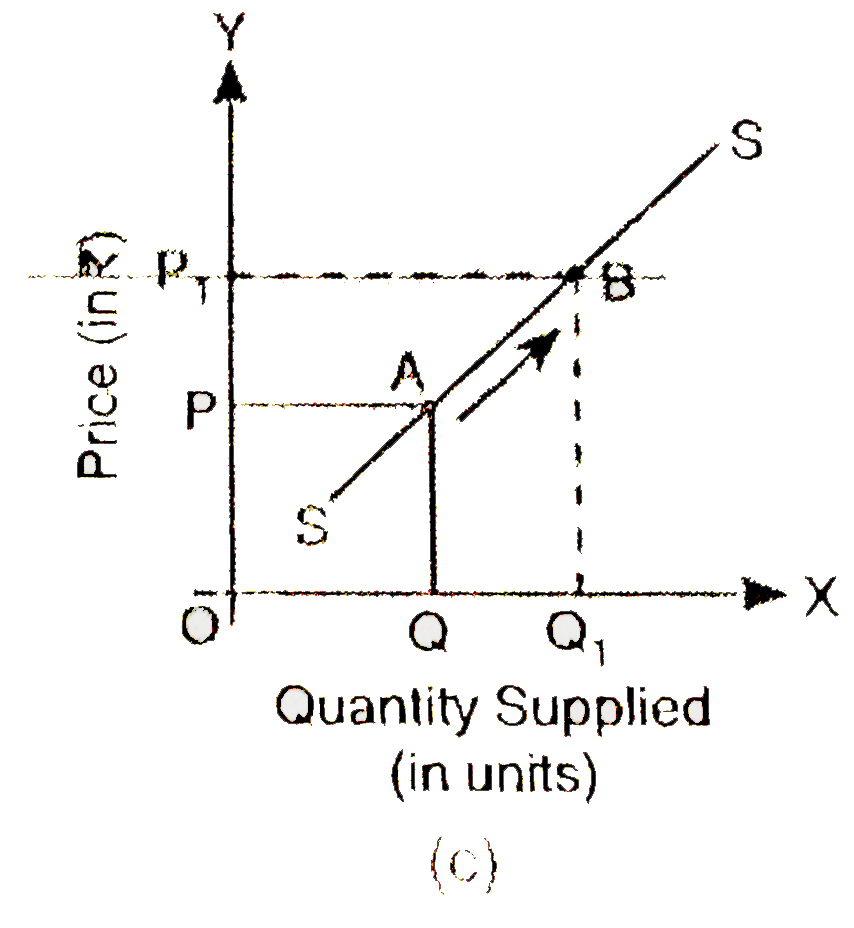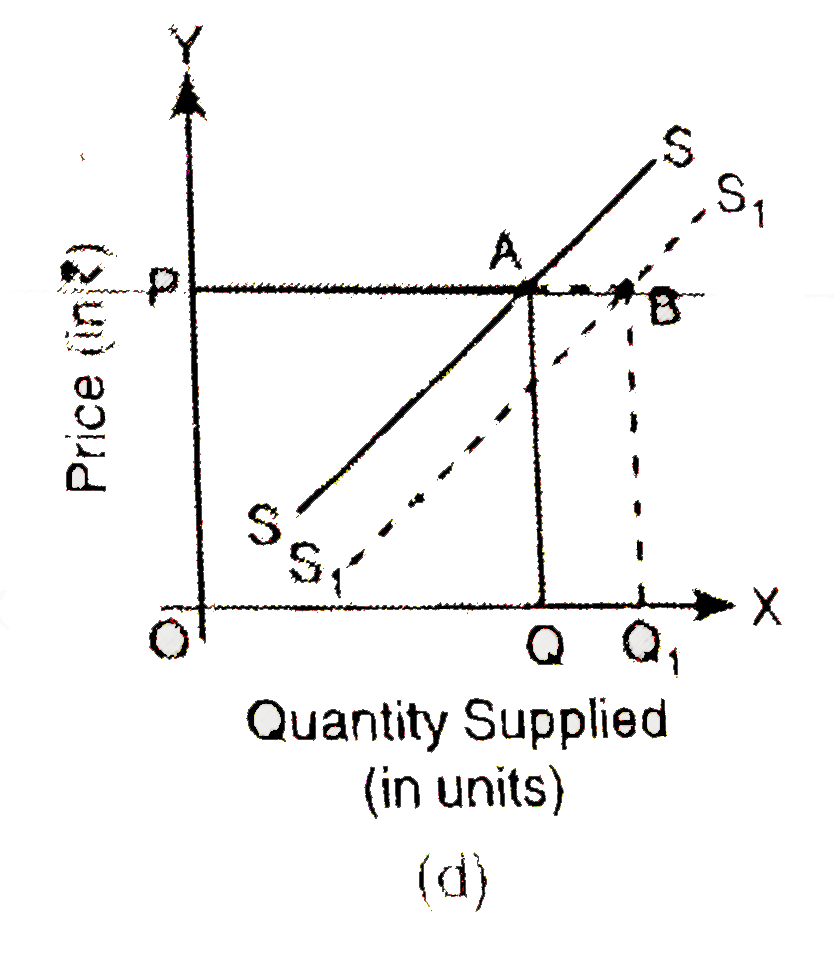(a) What is the effect of technological advancement on supply curve?
(b) How can a developing country prepare itself to achieve economic progress ?
(b) Production and supply should be increased to achieve economic progress. In economically backward countries, there is shortage of resources, so effeorts should be made to use available resources optimally and avoid their wastage and unutilisation.
Topper's Solved these Questions
- THEORY OF SUPPLY : LAW OF SUPPLY AND ELASTICITY OF SUPPLYBOOK - RADHA BHUGANACHAPTER - THEORY OF SUPPLY : LAW OF SUPPLY AND ELASTICITY OF SUPPLYEXERCISE - GUIDELINES TO NECRT QUESTIONS
10 Videos
- THEORY OF SUPPLY : LAW OF SUPPLY AND ELASTICITY OF SUPPLYBOOK - RADHA BHUGANACHAPTER - THEORY OF SUPPLY : LAW OF SUPPLY AND ELASTICITY OF SUPPLYEXERCISE - EXERCISES(VSATQ)
19 Videos
- THEORY OF SUPPLY : LAW OF SUPPLY AND ELASTICITY OF SUPPLYBOOK - RADHA BHUGANACHAPTER - THEORY OF SUPPLY : LAW OF SUPPLY AND ELASTICITY OF SUPPLYEXERCISE - HOTS
6 Videos
- THEORY OF DEMANDBOOK - RADHA BHUGANACHAPTER - THEORY OF DEMANDEXERCISE - UNSOLVED NUMERICALS
7 Videos
Similar Questions
Knowledge Check
Degradation o technology will have the following effect on the supply curves:
A B
B C
C D
D
Globalization is the objective trend of economic development in the world today, featured by free flow and optimized allocation of capital, technology, information and service in the global context. It is the inevitable result of the development of productive forces and advances of science and technology, especially the revolution of information technology since the 1880s and 1890s.
The influence of globalization on countries at different stages of development is entirely different. The "dividends" derived from globalization are not fairly distributed. The developed countries have apparent advantages in capital, technology, human resources and administrative expertise and in setting the "rules of the game". They are usually the biggest beneficiaries of globalization. The developing countries on the other hand are on the whole in an unfavorably position. Developing countries can obtain some foreign investment, advanced technologies and management expertise, but at the same time they are the most vulnerable to the negative impacts of globalization and lack the ability to effectively fend off and reduce the risks and pitfalls that come along with globalization. In the 1890s, especially in recent years, the gap between the North and the South has further widened. The economic sovereignty and economic security of the developing countries are confronted with enormous pressure and stern challenges. Some least-developed countries are even on the brink of being marginalized by globalization. Therefore, in participation of globalization, developing countries should always be on alert and try by all means to exploit the advantages and avoid all kinds ofrisk and harm.
In the past 20-odd years, China has maintained an annual growth rate of over 9.3% on average. China is now the 6th largest economy and the 5th largest trading nation in the world. More than 200 million people have been lifted out of poverty. The above accomplishments were achieved against the backdrop of a volatile international situation. The reason why China was so successful in such a short period of time and in a constantly changing international environment is because China has found its own road of development i.e, to. base what we do on the realities of China while sticking to the basic system of socialism, reforms should be carried out to solve the problems of incompatibility between the productive forces and the relations of production, and between economic base and the superstructure, so as to achieve self-perfection of socialism. Every country is different from the other.
It opens not only to developed countries, but also to developing countries, not only in economic field, but also in all areas of social development. At the same time, it is not a blind opening, but a self-conscious one, not a disorganized opening but a systematic one. China's opening proceeds and deepens in a gradual and step by step fashion. It started from the 4 special economic zones, to coastal cities, then to capital cities ofinland provinces and now it has reached an unprecedented stage of all- round opening demonstrated by China's accession to the World Trade Organization. During its opening-up, China paid special attention to give full play to its comparative advantages to actively conduct international cooperation and competition. For instance, China has fully exploited its advantages oflow cost oflabour to attract foreign investment and technology to push economic development and better efficiency and quality of economic growth. These measures have brought the Chinese economy increasingly integrated with the world economy.
China has learnt many lessons and accumulated rich experiences in dealing with globalisation from its practice of refonn and opening-up. To adopt opening-up policy. It opens not only to developed countries, but also to developing countries, not only in economic field, but also in all areas of social development. At the same time, it is not a blind opening, but a self-conscious one, not a disorganized opening but a systematic one. China's opening proceeds and deepens in a gradual and step by step fashion. It started from the 4 special economic zones, to coastal cities, then to capital cities of inland provinces and now it has reached an unprecedented stage of all-round opening demonstrated by China's accession to the World Trade Organization. During its opening-up, China paid special attention to give full play to its comparative advantages to actively conduct international cooperation and competition.
China's participation in Globalization is by no means a one-way street. When the world economic growth remains weak, China's economy is one of the few bright spots. As torld Bank Report on Global Development Finance 2003 publtshed in early April pointed out that China's fast growth "helped to drive the recovery in East Asia. Together with policy stimulus in other countries, China's performance lifted the region to growth of6.7 % in 2002, up from 5.5% in 2001.China has also provided the world with the largest rising market. When more than 1.25 billion people become well-off, the demand on everything will be enormous. Just to give you an example, in the coming 10 years alone, China will import US$ 2 trillion of goods from the outside world. It goes without saying that we are also facing many challenges. For instance, with the accession to the WTO, China is faced with growing pressure from international competition. China's enterprises have to cope with fiercer competition not only at international market, but at home market as well. Nevertheless, opening the country to the outside world is China's basic and longterm state policy. China is committed to opening still wider to the outside world in an all- directional and multi-tiered way, with an even· more active approach.
Which of the following is the most suitable term for the nature of Chinese opening to the outside world?AProgressiveBSelf consciousCComprehensiveDDiscerningGlobalization is the objective trend of economic development in the world today, featured by free flow and optimized allocation of capital, technology, information and service in the global context. It is the inevitable result of the development of productive forces and advances of science and technology, especially the revolution of information technology since the 1880s and 1890s.
The influence of globalization on countries at different stages of development is entirely different. The "dividends" derived from globalization are not fairly distributed. The developed countries have apparent advantages in capital, technology, human resources and administrative expertise and in setting the "rules of the game". They are usually the biggest beneficiaries of globalization. The developing countries on the other hand are on the whole in an unfavorably position. Developing countries can obtain some foreign investment, advanced technologies and management expertise, but at the same time they are the most vulnerable to the negative impacts of globalization and lack the ability to effectively fend off and reduce the risks and pitfalls that come along with globalization. In the 1890s, especially in recent years, the gap between the North and the South has further widened. The economic sovereignty and economic security of the developing countries are confronted with enormous pressure and stern challenges. Some least-developed countries are even on the brink of being marginalized by globalization. Therefore, in participation of globalization, developing countries should always be on alert and try by all means to exploit the advantages and avoid all kinds ofrisk and harm.
In the past 20-odd years, China has maintained an annual growth rate of over 9.3% on average. China is now the 6th largest economy and the 5th largest trading nation in the world. More than 200 million people have been lifted out of poverty. The above accomplishments were achieved against the backdrop of a volatile international situation. The reason why China was so successful in such a short period of time and in a constantly changing international environment is because China has found its own road of development i.e, to. base what we do on the realities of China while sticking to the basic system of socialism, reforms should be carried out to solve the problems of incompatibility between the productive forces and the relations of production, and between economic base and the superstructure, so as to achieve self-perfection of socialism. Every country is different from the other.
It opens not only to developed countries, but also to developing countries, not only in economic field, but also in all areas of social development. At the same time, it is not a blind opening, but a self-conscious one, not a disorganized opening but a systematic one. China's opening proceeds and deepens in a gradual and step by step fashion. It started from the 4 special economic zones, to coastal cities, then to capital cities ofinland provinces and now it has reached an unprecedented stage of all- round opening demonstrated by China's accession to the World Trade Organization. During its opening-up, China paid special attention to give full play to its comparative advantages to actively conduct international cooperation and competition. For instance, China has fully exploited its advantages oflow cost oflabour to attract foreign investment and technology to push economic development and better efficiency and quality of economic growth. These measures have brought the Chinese economy increasingly integrated with the world economy.
China has learnt many lessons and accumulated rich experiences in dealing with globalisation from its practice of refonn and opening-up. To adopt opening-up policy. It opens not only to developed countries, but also to developing countries, not only in economic field, but also in all areas of social development. At the same time, it is not a blind opening, but a self-conscious one, not a disorganized opening but a systematic one. China's opening proceeds and deepens in a gradual and step by step fashion. It started from the 4 special economic zones, to coastal cities, then to capital cities of inland provinces and now it has reached an unprecedented stage of all-round opening demonstrated by China's accession to the World Trade Organization. During its opening-up, China paid special attention to give full play to its comparative advantages to actively conduct international cooperation and competition.
China's participation in Globalization is by no means a one-way street. When the world economic growth remains weak, China's economy is one of the few bright spots. As torld Bank Report on Global Development Finance 2003 publtshed in early April pointed out that China's fast growth "helped to drive the recovery in East Asia. Together with policy stimulus in other countries, China's performance lifted the region to growth of6.7 % in 2002, up from 5.5% in 2001.China has also provided the world with the largest rising market. When more than 1.25 billion people become well-off, the demand on everything will be enormous. Just to give you an example, in the coming 10 years alone, China will import US$ 2 trillion of goods from the outside world. It goes without saying that we are also facing many challenges. For instance, with the accession to the WTO, China is faced with growing pressure from international competition. China's enterprises have to cope with fiercer competition not only at international market, but at home market as well. Nevertheless, opening the country to the outside world is China's basic and longterm state policy. China is committed to opening still wider to the outside world in an all- directional and multi-tiered way, with an even· more active approach.
How according to author China is contributing to World Economy?ABy giving the road development to other developing co.untries so that they can follow the same path.BBy providing a huge market to the World to supply the needs of billion uplifted Chinese populationCBy new advancements in technology and human resources.DFocusing their attention to conduct international cooperation and competition.
How does technological progress affect the supply curve of a firm?
View SolutionWhat will be the effect of a rightward shift ofthe supply curve on the equilibrium price and quantity transacted?
View SolutionHow can the goods of development be achieved?
View SolutionGlobalization is the objective trend of economic development in the world today, featured by free flow and optimized allocation of capital, technology, information and service in the global context. It is the inevitable result of the development of productive forces and advances of science and technology, especially the revolution of information technology since the 1880s and 1890s.
The influence of globalization on countries at different stages of development is entirely different. The "dividends" derived from globalization are not fairly distributed. The developed countries have apparent advantages in capital, technology, human resources and administrative expertise and in setting the "rules of the game". They are usually the biggest beneficiaries of globalization. The developing countries on the other hand are on the whole in an unfavorably position. Developing countries can obtain some foreign investment, advanced technologies and management expertise, but at the same time they are the most vulnerable to the negative impacts of globalization and lack the ability to effectively fend off and reduce the risks and pitfalls that come along with globalization. In the 1890s, especially in recent years, the gap between the North and the South has further widened. The economic sovereignty and economic security of the developing countries are confronted with enormous pressure and stern challenges. Some least-developed countries are even on the brink of being marginalized by globalization. Therefore, in participation of globalization, developing countries should always be on alert and try by all means to exploit the advantages and avoid all kinds ofrisk and harm.
In the past 20-odd years, China has maintained an annual growth rate of over 9.3% on average. China is now the 6th largest economy and the 5th largest trading nation in the world. More than 200 million people have been lifted out of poverty. The above accomplishments were achieved against the backdrop of a volatile international situation. The reason why China was so successful in such a short period of time and in a constantly changing international environment is because China has found its own road of development i.e, to. base what we do on the realities of China while sticking to the basic system of socialism, reforms should be carried out to solve the problems of incompatibility between the productive forces and the relations of production, and between economic base and the superstructure, so as to achieve self-perfection of socialism. Every country is different from the other.
It opens not only to developed countries, but also to developing countries, not only in economic field, but also in all areas of social development. At the same time, it is not a blind opening, but a self-conscious one, not a disorganized opening but a systematic one. China's opening proceeds and deepens in a gradual and step by step fashion. It started from the 4 special economic zones, to coastal cities, then to capital cities ofinland provinces and now it has reached an unprecedented stage of all- round opening demonstrated by China's accession to the World Trade Organization. During its opening-up, China paid special attention to give full play to its comparative advantages to actively conduct international cooperation and competition. For instance, China has fully exploited its advantages oflow cost oflabour to attract foreign investment and technology to push economic development and better efficiency and quality of economic growth. These measures have brought the Chinese economy increasingly integrated with the world economy.
China has learnt many lessons and accumulated rich experiences in dealing with globalisation from its practice of refonn and opening-up. To adopt opening-up policy. It opens not only to developed countries, but also to developing countries, not only in economic field, but also in all areas of social development. At the same time, it is not a blind opening, but a self-conscious one, not a disorganized opening but a systematic one. China's opening proceeds and deepens in a gradual and step by step fashion. It started from the 4 special economic zones, to coastal cities, then to capital cities of inland provinces and now it has reached an unprecedented stage of all-round opening demonstrated by China's accession to the World Trade Organization. During its opening-up, China paid special attention to give full play to its comparative advantages to actively conduct international cooperation and competition.
China's participation in Globalization is by no means a one-way street. When the world economic growth remains weak, China's economy is one of the few bright spots. As torld Bank Report on Global Development Finance 2003 publtshed in early April pointed out that China's fast growth "helped to drive the recovery in East Asia. Together with policy stimulus in other countries, China's performance lifted the region to growth of6.7 % in 2002, up from 5.5% in 2001.China has also provided the world with the largest rising market. When more than 1.25 billion people become well-off, the demand on everything will be enormous. Just to give you an example, in the coming 10 years alone, China will import US$ 2 trillion of goods from the outside world. It goes without saying that we are also facing many challenges. For instance, with the accession to the WTO, China is faced with growing pressure from international competition. China's enterprises have to cope with fiercer competition not only at international market, but at home market as well. Nevertheless, opening the country to the outside world is China's basic and longterm state policy. China is committed to opening still wider to the outside world in an all- directional and multi-tiered way, with an even· more active approach.
Why the "dividends" derived from globalization are not fairly distributed?
View SolutionGlobalization is the objective trend of economic development in the world today, featured by free flow and optimized allocation of capital, technology, information and service in the global context. It is the inevitable result of the development of productive forces and advances of science and technology, especially the revolution of information technology since the 1880s and 1890s.
The influence of globalization on countries at different stages of development is entirely different. The "dividends" derived from globalization are not fairly distributed. The developed countries have apparent advantages in capital, technology, human resources and administrative expertise and in setting the "rules of the game". They are usually the biggest beneficiaries of globalization. The developing countries on the other hand are on the whole in an unfavorably position. Developing countries can obtain some foreign investment, advanced technologies and management expertise, but at the same time they are the most vulnerable to the negative impacts of globalization and lack the ability to effectively fend off and reduce the risks and pitfalls that come along with globalization. In the 1890s, especially in recent years, the gap between the North and the South has further widened. The economic sovereignty and economic security of the developing countries are confronted with enormous pressure and stern challenges. Some least-developed countries are even on the brink of being marginalized by globalization. Therefore, in participation of globalization, developing countries should always be on alert and try by all means to exploit the advantages and avoid all kinds ofrisk and harm.
In the past 20-odd years, China has maintained an annual growth rate of over 9.3% on average. China is now the 6th largest economy and the 5th largest trading nation in the world. More than 200 million people have been lifted out of poverty. The above accomplishments were achieved against the backdrop of a volatile international situation. The reason why China was so successful in such a short period of time and in a constantly changing international environment is because China has found its own road of development i.e, to. base what we do on the realities of China while sticking to the basic system of socialism, reforms should be carried out to solve the problems of incompatibility between the productive forces and the relations of production, and between economic base and the superstructure, so as to achieve self-perfection of socialism. Every country is different from the other.
It opens not only to developed countries, but also to developing countries, not only in economic field, but also in all areas of social development. At the same time, it is not a blind opening, but a self-conscious one, not a disorganized opening but a systematic one. China's opening proceeds and deepens in a gradual and step by step fashion. It started from the 4 special economic zones, to coastal cities, then to capital cities ofinland provinces and now it has reached an unprecedented stage of all- round opening demonstrated by China's accession to the World Trade Organization. During its opening-up, China paid special attention to give full play to its comparative advantages to actively conduct international cooperation and competition. For instance, China has fully exploited its advantages oflow cost oflabour to attract foreign investment and technology to push economic development and better efficiency and quality of economic growth. These measures have brought the Chinese economy increasingly integrated with the world economy.
China has learnt many lessons and accumulated rich experiences in dealing with globalisation from its practice of refonn and opening-up. To adopt opening-up policy. It opens not only to developed countries, but also to developing countries, not only in economic field, but also in all areas of social development. At the same time, it is not a blind opening, but a self-conscious one, not a disorganized opening but a systematic one. China's opening proceeds and deepens in a gradual and step by step fashion. It started from the 4 special economic zones, to coastal cities, then to capital cities of inland provinces and now it has reached an unprecedented stage of all-round opening demonstrated by China's accession to the World Trade Organization. During its opening-up, China paid special attention to give full play to its comparative advantages to actively conduct international cooperation and competition.
China's participation in Globalization is by no means a one-way street. When the world economic growth remains weak, China's economy is one of the few bright spots. As torld Bank Report on Global Development Finance 2003 publtshed in early April pointed out that China's fast growth "helped to drive the recovery in East Asia. Together with policy stimulus in other countries, China's performance lifted the region to growth of6.7 % in 2002, up from 5.5% in 2001.China has also provided the world with the largest rising market. When more than 1.25 billion people become well-off, the demand on everything will be enormous. Just to give you an example, in the coming 10 years alone, China will import US$ 2 trillion of goods from the outside world. It goes without saying that we are also facing many challenges. For instance, with the accession to the WTO, China is faced with growing pressure from international competition. China's enterprises have to cope with fiercer competition not only at international market, but at home market as well. Nevertheless, opening the country to the outside world is China's basic and longterm state policy. China is committed to opening still wider to the outside world in an all- directional and multi-tiered way, with an even· more active approach.
Which of the following statement is false?
View Solution
